The global zinc oxide for sunscreens market is projected to grow from USD 2,851.6 million in 2025 to approximately USD 8,753.4 million by 2035, recording an absolute increase of USD 5,901.8 million over the forecast period. This translates into a total growth of 207.0%, with the market forecast to expand at a compound annual growth rate (CAGR) of 11.9% between 2025 and 2035. The overall market size is expected to grow by nearly 3.07X during the same period, supported by the rising awareness of skin protection, increasing demand for mineral-based sunscreens, and growing consumer preference for safe and effective UV protection solutions.
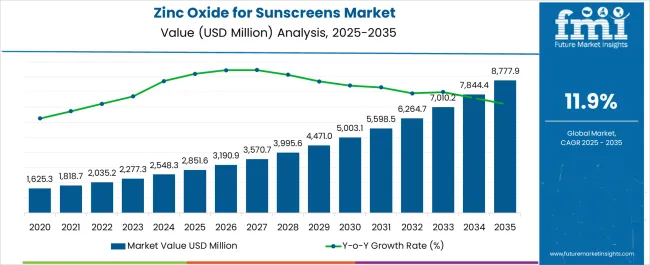
Between 2025 and 2030, the zinc oxide for sunscreens market is projected to expand from USD 2,851.6 million to USD 4,996.1 million, resulting in a value increase of USD 2,144.5 million, which represents 36.3% of the total forecast growth for the decade. This phase of growth will be shaped by increasing consumer awareness about skin cancer prevention, rising demand for mineral-based and reef-safe formulations, and growing penetration of premium sun care products in emerging markets. Manufacturers are expanding their product portfolios to address the growing complexity of consumer preferences for natural, safe, and effective sun protection solutions.
From 2030 to 2035, the market is forecast to grow from USD 4,996.1 million to USD 8,777.9 million, adding another USD 3,757.3 million, which constitutes 63.7% of the overall ten-year expansion. This period is expected to be characterized by innovation in nanotechnology applications, development of advanced surface-treated zinc oxide formulations, and expansion of specialized products for sensitive skin and baby care segments. The growing adoption of multifunctional sunscreens with blue light protection and anti-aging properties will drive demand for sophisticated zinc oxide formulations and specialized product development.
Between 2020 and 2025, the zinc oxide for sunscreens market experienced significant expansion, driven by increasing consumer awareness of mineral sunscreen benefits, growing concerns about chemical UV filters, and rising demand for reef-safe formulations. The market developed as cosmetic manufacturers recognized the need for safer, more environmentally friendly sun protection ingredients. Regulatory bodies and environmental organizations began emphasizing the importance of mineral-based sunscreens for marine ecosystem protection and human health safety.
| Metric | Value |
|---|---|
| Estimated Value in (2025E) | USD 2,851.6 million |
| Forecast Value in (2035F) | USD 8,777.9 million |
| Forecast CAGR (2025 to 2035) | 11.9% |
Market expansion is being supported by the rapid increase in consumer awareness about skin cancer prevention and the corresponding demand for effective, safe UV protection solutions worldwide. Modern consumers are increasingly seeking mineral-based sunscreens that provide broad-spectrum protection without harmful chemical ingredients. The growing preference for zinc oxide stems from its physical blocking mechanism, safety profile, and suitability for sensitive skin applications including baby and children's products.
The increasing focus on environmental sustainability and marine ecosystem protection is driving demand for reef-safe zinc oxide formulations that do not contribute to coral bleaching or marine life disruption. Regulatory restrictions on chemical UV filters in various regions are further accelerating the adoption of mineral-based alternatives. Consumer education campaigns and dermatologist recommendations are establishing zinc oxide as the gold standard for safe and effective sun protection across all age groups and skin types.
The market is segmented by grade, function, product type, claim, channel, and region. By grade, the market is divided into non-nano zinc oxide, nano zinc oxide, surface-treated zinc oxide, and encapsulated zinc oxide. Based on function, the market is categorized into UV protection (broad spectrum), blue light protection, sensitive skin formulations, and mineral-based daily wear. In terms of product type, the market is segmented into sun creams, daily moisturizers with SPF, tinted sunscreens, and baby/kids sunscreens. By claim, the market is classified into reef-safe, natural/organic, fragrance-free, and dermatologist-tested. By channel, the market includes pharmacies, e-commerce, mass retail, and specialty beauty retail. Regionally, the market is divided into North America, Europe, Asia Pacific, Latin America, and Middle East & Africa.
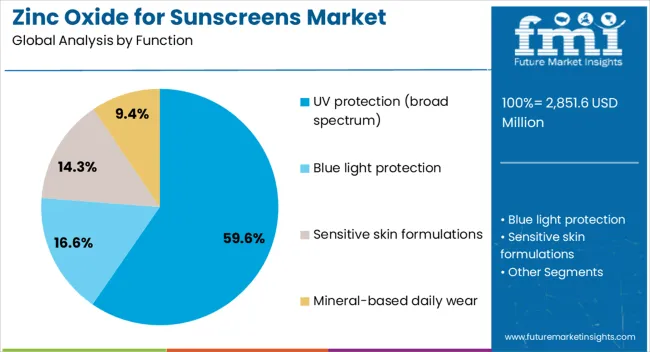
The UV protection (broad spectrum) function is projected to account for 59.6% of the zinc oxide for sunscreens market in 2025. This dominant share reflects the critical role of zinc oxide as one of the few UV filters capable of providing effective coverage against both UVA and UVB rays. Broad-spectrum protection has become the baseline consumer expectation for sunscreen performance, driven by rising awareness of photoaging, hyperpigmentation, and skin cancer risks linked to sun exposure.
Zinc oxide’s reputation as a safe, stable, and non-irritating mineral filter further strengthens its adoption, especially among sensitive-skin and pediatric product lines. Global regulatory approvals and inclusion in dermatologist-recommended formulations provide additional credibility. With demand growing for multifunctional sunscreens that combine protection with skincare benefits, zinc oxide remains central to broad-spectrum positioning, ensuring continued leadership of this function in the global sun care market.
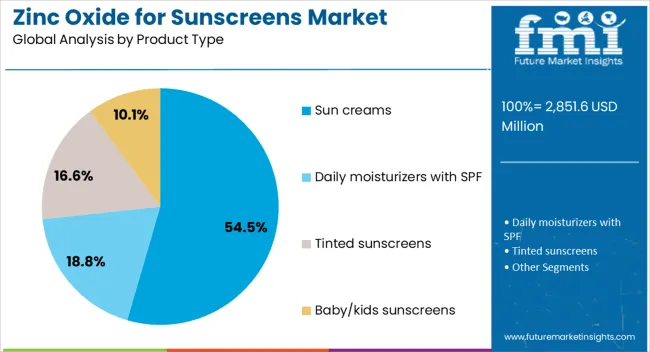
Sun creams are expected to represent 54.5% of zinc oxide sunscreen product demand in 2025. This leadership reflects the enduring consumer preference for traditional cream-based formats, which offer both familiarity and reliable performance. Cream formulations provide excellent flexibility for incorporating zinc oxide at concentrations necessary to deliver high SPF protection while also accommodating additional skincare actives such as antioxidants or moisturizers.
Advances in formulation technology are addressing previous drawbacks of mineral sunscreens, particularly the whitening or chalky effect of zinc oxide, by introducing micronized and nano-dispersed versions that improve spreadability and aesthetics. Consumer trust in cream formats, often perceived as more protective and longer lasting than sprays or gels, reinforces adoption. As multifunctional, cosmetically elegant sunscreens gain popularity, creams remain the anchor product type, bridging proven efficacy with an improved user experience.
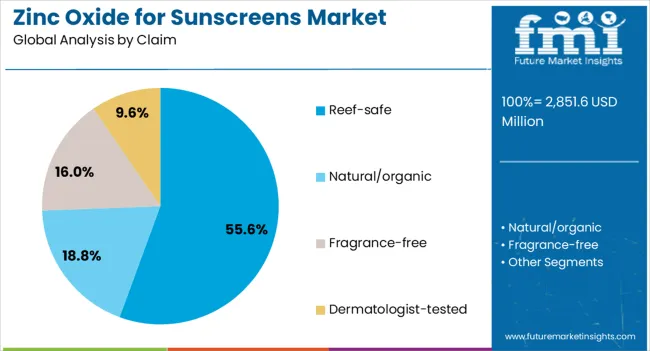
The reef-safe claim is forecasted to contribute 55.6% of the zinc oxide sunscreen market in 2025, with sales valued at USD 1,583.8 million. This dominance reflects heightened consumer awareness of the environmental impact of chemical UV filters on marine ecosystems, particularly coral reefs. Zinc oxide, as a non-toxic mineral filter, naturally aligns with reef-safe positioning, making it the preferred choice for eco-conscious formulations.
Growing regulatory actions in regions such as Hawaii, Palau, and parts of the Caribbean, where chemical filters like oxybenzone and octinoxate are banned, further reinforce demand for reef-safe alternatives. Consumers increasingly seek sun protection that balances personal health benefits with environmental responsibility, and reef-safe certification provides a strong differentiator in crowded sunscreen markets. With sustainability emerging as a mainstream purchase driver, reef-safe zinc oxide sunscreens are set to expand their influence, becoming a central pillar of both regulatory compliance and consumer trust.
The zinc oxide for sunscreens market is advancing rapidly due to increasing health consciousness and growing recognition of mineral sunscreen superiority. However, the market faces challenges including formulation difficulties with zinc oxide, higher raw material costs compared to chemical alternatives, and aesthetic concerns related to white residue and thick texture. Innovation in nanotechnology applications and surface treatment technologies continue to influence product development and market acceptance patterns.
The growing development of nano zinc oxide and surface-treated formulations is enabling improved cosmetic elegance and user acceptance without compromising protection efficacy. Advanced surface treatments reduce the characteristic white appearance while maintaining broad-spectrum UV protection capabilities. These innovations are particularly important for facial sunscreens and daily-wear products where aesthetic appeal is crucial for consumer adoption and regular use compliance.
Modern zinc oxide sunscreen formulations are incorporating additional benefits including blue light protection, anti-aging properties, and skin-calming ingredients that address comprehensive skin health needs. Integration of antioxidants, moisturizing agents, and color-correcting properties creates value-added products that meet multiple consumer needs in single formulations. Advanced formulations also support specific skin concerns including sensitive skin, acne-prone skin, and mature skin requirements.
The zinc oxide for sunscreens market in Europe demonstrates advanced development across major economies with Germany establishing leadership through its precision chemical manufacturing capabilities and innovative mineral sunscreen technologies, supported by companies like BASF, DSM-Firmenich, Evonik, and Symrise pioneering cutting-edge zinc oxide formulations that offer superior UV protection while addressing aesthetic concerns through advanced particle engineering and surface treatments. France represents a significant market driven by its luxury beauty heritage and sophisticated understanding of sun protection science, with companies like L'Oréal developing premium zinc oxide sunscreen formulations that combine French cosmetic artistry with mineral protection technology for elegant, effective broad-spectrum coverage.
The UK shows considerable growth through its focus on clean beauty and reef-safe formulations, with brands like Croda leveraging specialty chemicals expertise to develop refined zinc oxide particles that enhance sunscreen performance and consumer acceptability. Italy and Spain exhibit expanding interest in mineral sun protection, particularly in premium zinc oxide formulations targeting sensitive skin and eco-conscious consumers. BENELUX countries contribute through their emphasis on sustainable and environmentally-friendly sun care solutions, while Eastern Europe and Nordic regions display growing potential driven by increasing awareness of mineral sunscreen benefits and expanding access to advanced zinc oxide-based protective products.
South Korea represents an emerging innovation center for zinc oxide sunscreens, positioning as a growing global market with sophisticated consumers increasingly embracing mineral sun protection and clean beauty principles that align with K-beauty philosophies of gentle effectiveness and comprehensive skin care approaches. The market benefits from extensive research capabilities in cosmetic science and nanotechnology, creating natural advantages for developing innovative zinc oxide processing techniques and novel delivery systems that enhance aesthetic properties while maintaining superior UV protection performance.
Strong domestic cosmetics manufacturing infrastructure supports both local consumption and significant export opportunities to global markets, particularly in Asia-Pacific regions where Korean sun care expertise is highly valued and trusted by consumers seeking effective yet gentle protection solutions. The integration of zinc oxide technology with Korean expertise in lightweight formulations and multi-functional skincare, combined with consumer sophistication in understanding ingredient safety and long-term skin protection strategies, positions the market as both an important consumer base and emerging innovation catalyst for zinc oxide sunscreen applications. Growing influence of K-beauty principles on global sun care trends emphasizes gentle mineral protection and comprehensive skin wellness, supporting continued market expansion and innovation development in zinc oxide-based sunscreen solutions worldwide.
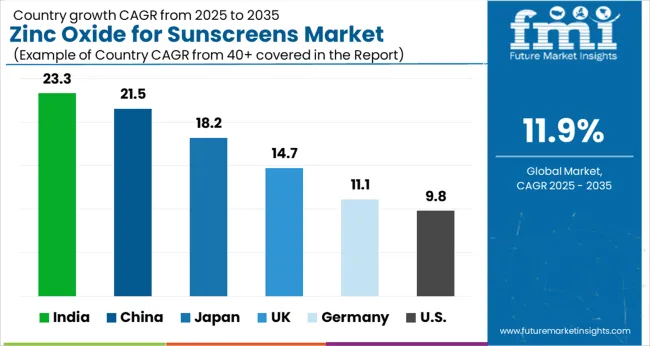
| Countries | CAGR (2025 to 2035) |
|---|---|
| China | 21.5% |
| USA | 9.8% |
| India | 23.3% |
| UK | 14.7% |
| Germany | 11.1% |
| Japan | 18.2% |
The zinc oxide for sunscreens market is growing rapidly across major regions, with China leading at a 21.5% CAGR through 2035, driven by massive consumer base expansion, increasing skin protection awareness, and rapid adoption of premium sun care products. India follows at 23.3%, supported by rising disposable income, growing beauty consciousness, and increasing penetration of international beauty brands. Japan grows steadily at 18.2%, emphasizing advanced formulation technologies and premium positioning. The United States records 9.8%, focusing on regulatory compliance, innovation leadership, and mature market optimization. The UK shows 14.7% growth, driven by increasing environmental consciousness and premium product demand. Overall, Asian markets emerge as the leading drivers of global zinc oxide sunscreen market expansion.
The report covers an in-depth analysis of 40+ countries; six top-performing countries are highlighted below.
Revenue from zinc oxide sunscreens in China is projected to exhibit strong growth with expanding consumer education about sun protection benefits and increasing adoption of mineral-based formulations. The country's growing middle class and rising beauty consciousness are creating significant demand for premium sun protection products. Major international and domestic brands are establishing comprehensive distribution networks to serve the expanding consumer base across urban and rural markets.
Revenue from zinc oxide sunscreens in India is expanding rapidly, supported by increasing beauty consciousness, growing awareness of skin protection benefits, and rising penetration of international beauty brands. The country's expanding middle class and increasing disposable income are driving demand for premium sun care products. Domestic and international manufacturers are gradually establishing capabilities to serve the diverse consumer preferences and price sensitivity across different market segments.
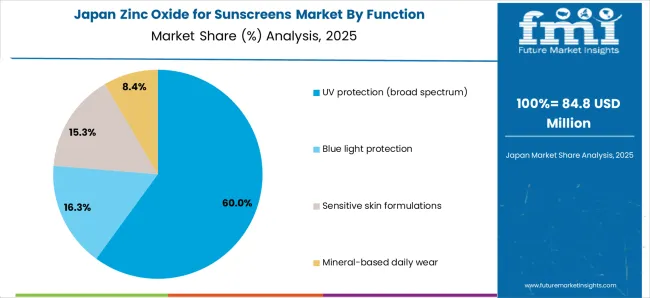
Revenue from zinc oxide sunscreens in Japan is growing steadily, driven by advanced formulation technologies, premium positioning, and sophisticated consumer preferences for high-quality sun protection products. The country's established beauty culture and emphasis on skin health are supporting demand for innovative zinc oxide formulations with superior cosmetic elegance. Japanese manufacturers continue to lead in developing advanced surface-treated and nano zinc oxide technologies that address aesthetic concerns while maintaining efficacy.
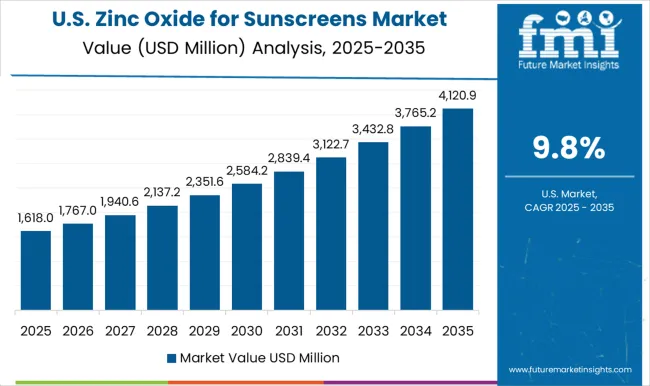
Demand for zinc oxide sunscreens in the U.S. is expanding steadily, driven by established regulatory framework, consumer health consciousness, and mature beauty market dynamics. American consumers demonstrate strong preference for dermatologist-recommended mineral sunscreens and reef-safe formulations. The market benefits from comprehensive retail distribution, professional recommendations, and established consumer education about zinc oxide benefits for skin health and environmental protection.
Demand for zinc oxide sunscreens in the UK is growing at a solid pace, supported by increasing environmental consciousness, premium beauty market development, and growing awareness of mineral sunscreen benefits. British consumers demonstrate strong preference for sustainable and environmentally friendly beauty products, driving demand for reef-safe zinc oxide formulations. The market is characterized by focus on natural ingredients, ethical positioning, and alignment with environmental values.
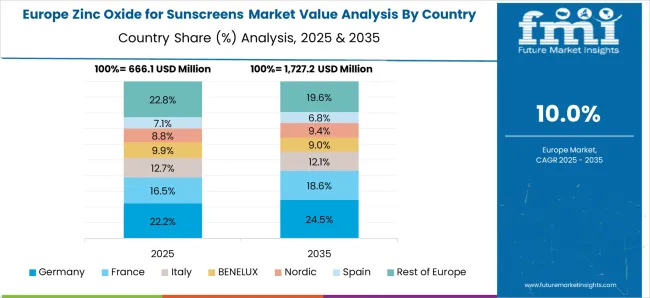
Revenue from zinc oxide sunscreens in Germany is projected to grow at a CAGR of 11.1% through 2035, supported by rising consumer demand for mineral-based sun protection solutions and strong trust in dermatologist-recommended skincare products. German consumers prioritize safety, efficacy, and clean-label transparency, making zinc oxide sunscreens an increasingly popular choice across both mass and premium beauty segments.
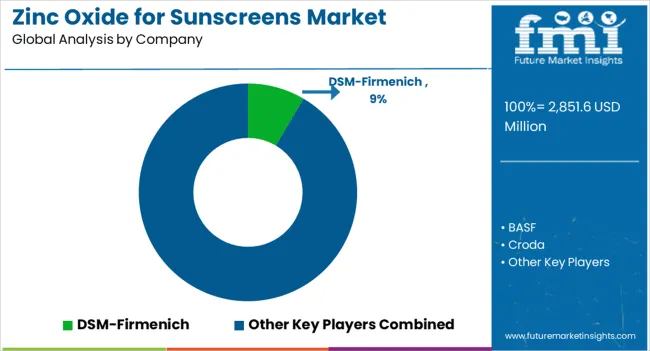
The zinc oxide for sunscreens market is characterized by competition among specialty chemical manufacturers, personal care companies, and integrated beauty conglomerates. Companies are investing in advanced formulation technologies, nanotechnology applications, sustainable sourcing practices, and comprehensive product portfolios to deliver effective, safe, and consumer-preferred zinc oxide solutions. Strategic partnerships, technological innovation, research and development, and market expansion are central to strengthening competitive positions and market presence.
DSM-Firmenich holds an 9% global value share in 2025, representing leadership in specialty chemical ingredients and advanced formulation technologies for personal care applications. Other market participants account for 91.5% of the market, indicating a highly fragmented competitive landscape with numerous regional and specialty players serving diverse market segments and geographical regions.
BASF, Germany-based, offers comprehensive zinc oxide solutions with emphasis on advanced surface treatments, nano formulations, and sustainable production practices. Croda, UK-headquartered, provides specialized zinc oxide ingredients with focus on cosmetic elegance, formulation compatibility, and technical support. DSM-Firmenich, globally operating, delivers innovative zinc oxide solutions with emphasis on sustainability, performance, and regulatory compliance. Symrise focuses on consumer-preferred formulations with enhanced aesthetics and multifunctional benefits.
Evonik emphasizes specialty surface treatments and advanced particle technologies for improved formulation performance. Kobo Products specializes in cosmetic-grade zinc oxide with focus on color cosmetics and aesthetic applications. Unilever integrates zinc oxide into comprehensive sun care product portfolios with emphasis on consumer brands and market accessibility. L'Oréal develops premium zinc oxide formulations for luxury and mass market beauty brands. Johnson & Johnson focuses on healthcare-oriented applications with emphasis on safety and dermatological recommendations. Neutrogena provides consumer-accessible zinc oxide products with dermatologist endorsement and clinical positioning.
| Items | Values |
|---|---|
| Quantitative Units (2025) | USD 2,851.6 Million |
| Grade | Non-nano zinc oxide, Nano zinc oxide, Surface-treated zinc oxide, Encapsulated zinc oxide |
| Function | UV protection (broad spectrum), Blue light protection, Sensitive skin formulations, Mineral-based daily wear |
| Product Type | Sun creams, Daily moisturizers with SPF, Tinted sunscreens, Baby/kids sunscreens |
| Claim | Reef-safe, Natural/organic, Fragrance-free, Dermatologist-tested |
| Channel | Pharmacies, E-commerce, Mass retail, Specialty beauty retail |
| Regions Covered | North America, Europe, Asia Pacific, Latin America, Middle East & Africa |
| Countries Covered | United States, Canada, United Kingdom, Germany, France, China, Japan, India, South Korea, Brazil, Australia and 40+ countries |
| Key Companies Profiled | BASF, Croda, DSM-Firmenich, Symrise, Evonik, Kobo Products, Unilever, L'Oréal, Johnson & Johnson, and Neutrogena |
| Additional Attributes | Dollar sales by particle size and formulation type, regional demand trends, competitive landscape, buyer preferences for mineral versus hybrid sunscreens, integration with clean-label/reef-safe positioning, innovations in micronization, dispersion stability, and transparent UV-filter technologies |
The global zinc oxide for sunscreens market is estimated to be valued at USD 2,851.6 million in 2025.
The market size for the zinc oxide for sunscreens market is projected to reach USD 8,777.9 million by 2035.
The zinc oxide for sunscreens market is expected to grow at a 11.9% CAGR between 2025 and 2035.
The key product types in zinc oxide for sunscreens market are uv protection (broad spectrum) , blue light protection, sensitive skin formulations and mineral-based daily wear.
In terms of claim , reef-safe segment to command 55.6% share in the zinc oxide for sunscreens market in 2025.






Full Research Suite comprises of:
Market outlook & trends analysis
Interviews & case studies
Strategic recommendations
Vendor profiles & capabilities analysis
5-year forecasts
8 regions and 60+ country-level data splits
Market segment data splits
12 months of continuous data updates
DELIVERED AS:
PDF EXCEL ONLINE
Zinc Acetate Market Size and Share Forecast Outlook 2025 to 2035
Zinc Dialkyldithiophosphates Additive Market Size and Share Forecast Outlook 2025 to 2035
Zinc Carbonate Market Size and Share Forecast Outlook 2025 to 2035
Zinc Chloride Market Analysis - Size, Share, and Forecast 2025 to 2035
Zinc Citrate Market Size and Share Forecast Outlook 2025 to 2035
Zinc Chemicals Market Size and Share Forecast Outlook 2025 to 2035
Zinc Sulphate Market Size, Growth, and Forecast 2025 to 2035
Zinc Methionine Chelates Market - Growth & Demand 2025 to 2035
Zinc-Air Batteries Market Growth – Trends & Forecast 2023-2033
Zinc Oxide Block Market Size and Share Forecast Outlook 2025 to 2035
Zinc Oxide Market Forecast and Outlook 2025 to 2035
Zinc Oxide Sunscreens Market Size and Share Forecast Outlook 2025 to 2035
Nano Zinc Oxide Market Size and Share Forecast Outlook 2025 to 2035
Inorganic Zinc Coatings Market Size and Share Forecast Outlook 2025 to 2035
Encapsulated Zinc Feed Market Analysis - Size and Share Forecast Outlook 2025 to 2035
Agricultural Grade Zinc Chemicals Market Growth - Trends & Forecast 2025 to 2035
High Voltage Ceramic Zinc Oxide Surge Arrester Market Size and Share Forecast Outlook 2025 to 2035
Iron Oxide Market Report - Growth, Demand & Forecast 2025 to 2035
Metal Oxide Film Fixed Resistor Market Size and Share Forecast Outlook 2025 to 2035
Amine Oxide Market Size and Share Forecast Outlook 2025 to 2035

Thank you!
You will receive an email from our Business Development Manager. Please be sure to check your SPAM/JUNK folder too.
Chat With
MaRIA